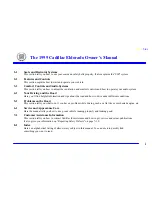
Note: This procedure is not used in Brazil.
• GM vehicles are designed to operate under normal environmental conditions.
• The design criteria for sealing materials and components takes into consideration the sealing forces required to withstand
the natural elements. These specifications cannot take into consideration any artificial conditions, i.e., high pressure car
washes.
• The water leak test procedure has been correlated to the natural elements and will determine the ability of a vehicle to
perform under normal operating conditions.
• The first step in diagnosing a leak is determining the conditions under which a leak occurs. If the general leak area can be
found, the exact entry point can be isolated using a water hose or an air hose. Some trim panels or components may need
to be removed in order to repair the leak.
• If leaks are found around a door, door window, rear compartment lid or liftgate area this does not necessarily indicate a
bad weatherstrip. An adjustment to these areas may resolve the condition.
1. Assemble the water test stand as shown.
2. Position the stands as shown.
The water spray from the stands should overlap the vehicle as shown.
3. Have an assistant inside of the vehicle during the test in order to locate any leaks.
4. The water pressure at the nozzle should maintain a 155
kPa (22
psi), for at least 4
minutes.
5. In order to check the windshield, aim the water spray 30
degrees down and 45
degrees toward the rear.
Aim the water towards the corner of the windshield.
6. In order to check the side windows for leaks, position the water stand towards the center of the rear quarter, aiming the
water spray 30
degrees down and 45
degrees toward the rear.
7. In order to check the back window, aim the water spray 30
degrees down and 30
degrees toward the front.
© 2011 General Motors. All rights reserved.
0-1
General
GENERAL INFORMATION
BACK TO CHAPTER INDEX
Waterleak Test Preparation
TO MODEL INDEX
CHEVROLET SONIC 2012 BODY REPAIR MANUAL
















































